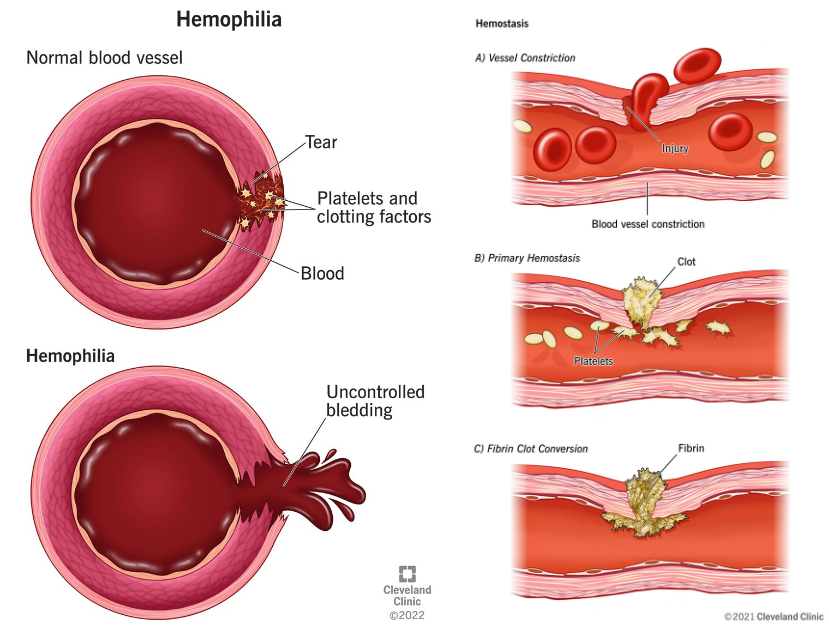How is your body able to control bleeding?
When there is some sort of trauma to a blood vessel that results in bleeding, the body’s normal mechanism to form a blood clot kicks into action. Platelets, a type of blood cell, reach the area in need of a clot and form a “plug,” where they release substances from their granules to activate clotting factor proteins. One such protein, fibrin, helps to stabilize the overall clot and prevent excessive bleeding from the injury (1). In a person diagnosed with a bleeding disorder, some aspect of the clot formation process is abnormal or disrupted.

What is a bleeding disorder?
When people hear the term “bleeding disorders,” hemophilia is what usually comes to mind. In most general biology courses, we learn that hemophilia is an X-linked condition in which the blood is unable to clot properly, due to various factor deficiencies. The term “factor” refers to clotting/coagulation factors, which are proteins implicated in the formation of blood clots to prevent excessive bleeding (2).
What are examples of lesser known bleeding disorders?
What many people fail to recognize is that “bleeding disorders” is a categorical term within which several disorders fall, not just hemophilia. Lesser known bleeding disorders include:
- von Willebrand’s disease – caused by a deficiency or a malfunction in a protein known as von Willebrand’s factor (3).
as well as rare and ultra-rare conditions, such as:
- Platelet storage pool disorders including but not limited to –
- Alpha storage pool deficiency (ASPD) – caused by either too few or irregular alpha granules in the blood (4). Alpha granules contain clotting proteins, such as fibrinogen, fibronectin, and thrombospondin (5). ASPD can also result from reduced protein contents within the alpha granules, as well as from issues in the release of the granule contents to form a clot (6).
- Glanzmann’s thrombasthenia – caused by the faulty production of a protein called integrin alpha IIb/beta 3 (7).
- Other factor deficiencies – caused by deficiencies in factors I, II, V, VII, X, XII, and XIII (8).
Why is understanding these proteins so important?
As these conditions demonstrate, many instances of bleeding disorders are caused by a deficiency in one or more proteins implicated in blood clotting, thus the tell-tale symptoms of spontaneous nosebleeds, prolonged menstrual and/or childbirth-related bleeding, frequent bruising, and excessive bleeding following both routine and traumatic injury in diagnosed individuals (9). By better understanding protein interactions within the blood, particularly those implicated in clotting, we are in a better place to treat and diagnose the wide and diverse spectrum of bleeding disorders that exist throughout the population.
How are bleeding disorders treated?
Some treatment options for bleeding disorders include factor replacement therapy, where the deficient or absent factor is given to a patient (10). For example, factor VIII or von Willebrand’s factor might be administered via an IV line, but this is of course dependent upon a thorough consultation of an individual’s diagnosis and history with a hematologist. Such treatments represent the immense importance of understanding protein interactions within the blood and how harnessing the power of clotting factors can help patients manage symptoms and prevent bleeds.
Why is biochemical research so important?
Grounding biochemistry research in the realities of patients means contextualizing them as something beyond a particle suspended in a buffer after purification. Rather, they are a vital piece of the puzzle in understanding a given disorder, as well as in researching the under-studied rare disorders of the community. Making strides to treat rare hematological disorders starts at the lab bench.
Paxton Mills
Biochemistry and Molecular Biology Major
Class of 2026
References
- “Hemostasis.” Cleveland Clinic. Available online at https://my.clevelandclinic.org/health/symptoms/21999-hemostasis.
- “Hemophilia.” Cleveland Clinic. Available online at https://my.clevelandclinic.org/health/diseases/14083-hemophilia.
- “About von Willebrand Disease.” Centers for Disease Control and Prevention. Available online at https://www.cdc.gov/von-willebrand/about/index.html#:~:text=Von%20Willebrand%20disease%20(VWD)%20is,the%20most%20common%20bleeding%20disorder..
- “Platelet Function Disorders.” UC Davis Health Hemostasis and Thrombosis Center. Available online at https://health.ucdavis.edu/hemophilia/bleeding-disorders/platelet-function-disorders.html#:~:text=Delta%20storage%20pool%20deficiency%20is,constrict%20to%20help%20stop%20bleeding..
- Wahed, A., & Dasgupta, A. (2015). Chapter 15 – Essentials of Coagulation. In A. Wahed & A. Dasgupta (Eds.), Hematology and Coagulation: A Comprehensive Review for Board Preparation, Certification and Clinical Practice (231-261). Elsevier. https://doi.org/10.1016/B978-0-12-800241-4.00015-2
- “Platelet Function Disorders.” UC Davis Health Hemostasis and Thrombosis Center. Available online at https://health.ucdavis.edu/hemophilia/bleeding-disorders/platelet-function-disorders.html#:~:text=Delta%20storage%20pool%20deficiency%20is,constrict%20to%20help%20stop%20bleeding..
- “Glanzmann Thrombasthenia.” Cleveland Clinic. Available online at https://my.clevelandclinic.org/health/diseases/glanzmann-thrombasthenia.
- “Other Factor Deficiencies.” National Bleeding Disorders Foundation. Available online at https://www.bleeding.org/bleeding-disorders-a-z/types/other-factor-deficiencies?utm_source=google&utm_medium=cpc&utm_campaign=lead_generation&utm_term=communications&utm_content=rare_bleeding_disorders&gad_source=1&gclid=CjwKCAjw1emzBhB8EiwAHwZZxUS861vAlMwE9-DTWIuynXI_nXS5FB2AgCTD2_b_UwUZID-_Vl_UmhoCBD8QAvD_BwE.
- “Bleeding Disorders Symptoms.” NIH National Heart, Lung, and Blood Institute. Available online at https://www.nhlbi.nih.gov/health/bleeding-disorders/symptoms.
- “Bleeding Disorders Treatment.” NIH National Heart, Lung, and Blood Institute. Available online at https://www.nhlbi.nih.gov/health/bleeding-disorders/treatment.

Recent Comments